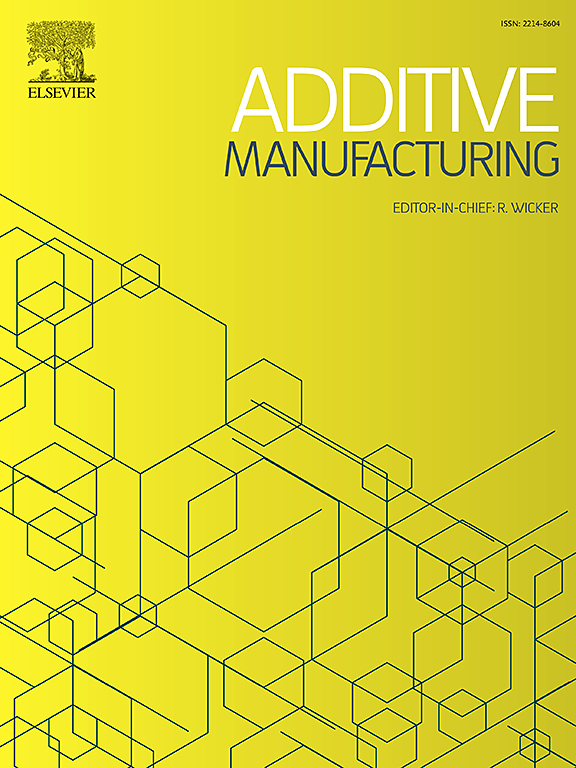Mechanistic study of fiber damage evolution in 3D printing of two-matrix continuous carbon fiber-reinforced composites based on electrical conductivity changes
IF 10.3
1区 工程技术
Q1 ENGINEERING, MANUFACTURING
引用次数: 0
Abstract
This study addresses the critical issue of fiber breakage defects that significantly affect the mechanical performance of 3D printed two-matrix continuous carbon fiber-reinforced composites. A conductivity-based method is proposed to characterize the extent of fiber fracture during the printing process. The entire process is segmented into five stages, from the raw two-matrix prepreg filament (Stage 1) to the final printed part (Stage 5). The relationship between fiber breakage and electrical conductivity at different stages is systematically investigated, verifying the effectiveness of electrical conductivity as an indicator for assessing fiber continuity and damage severity. Experimental analysis under varying processing parameters further reveals that the electrical conductivity of printed part is highly sensitive to both printing speed and temperature. These findings indicate that conductivity monitoring can effectively capture the degradation in mechanical performance caused by microscale defects, offering valuable guidance for process parameters optimization. Within the given process and parameter range in this paper, the optimal process parameter combination is a printing temperature of 210°C and a printing speed coefficient of 3. Finally, by integrating thermal property analysis and microstructural characterization, the study elucidates a damage evolution mechanism dominated by epoxy softening-induced interfacial failure and thermo-temporal stress accumulation. This mechanism collectively drives the fracture of continuous carbon fibers during printing, laying the groundwork for future multiscale modeling of damage evolution in two-matrix continuous carbon fiber-reinforced composites.
基于电导率变化的双基连续碳纤维增强复合材料3D打印过程中纤维损伤演化机理研究
本研究解决了影响3D打印双基连续碳纤维增强复合材料力学性能的纤维断裂缺陷这一关键问题。提出了一种基于电导率的方法来表征打印过程中纤维断裂的程度。整个过程分为五个阶段,从原始的双基体预浸料长丝(阶段1)到最终的打印部件(阶段5)。系统研究了不同阶段纤维断裂与电导率之间的关系,验证了电导率作为评估纤维连续性和损伤严重程度的指标的有效性。在不同工艺参数下的实验分析进一步表明,打印件的电导率对打印速度和打印温度都非常敏感。这些结果表明,电导率监测可以有效地捕捉到微尺度缺陷引起的力学性能下降,为工艺参数优化提供了有价值的指导。在本文给定的工艺和参数范围内,最佳工艺参数组合为打印温度210℃,打印速度系数3。最后,结合热性能分析和微观结构表征,阐明了以环氧软化界面破坏和热-时间应力积累为主的损伤演化机制。这一机制共同驱动了连续碳纤维在打印过程中的断裂,为未来双基体连续碳纤维增强复合材料损伤演化的多尺度建模奠定了基础。
本文章由计算机程序翻译,如有差异,请以英文原文为准。
求助全文
约1分钟内获得全文
求助全文
来源期刊

Additive manufacturing
Materials Science-General Materials Science
CiteScore
19.80
自引率
12.70%
发文量
648
审稿时长
35 days
期刊介绍:
Additive Manufacturing stands as a peer-reviewed journal dedicated to delivering high-quality research papers and reviews in the field of additive manufacturing, serving both academia and industry leaders. The journal's objective is to recognize the innovative essence of additive manufacturing and its diverse applications, providing a comprehensive overview of current developments and future prospects.
The transformative potential of additive manufacturing technologies in product design and manufacturing is poised to disrupt traditional approaches. In response to this paradigm shift, a distinctive and comprehensive publication outlet was essential. Additive Manufacturing fulfills this need, offering a platform for engineers, materials scientists, and practitioners across academia and various industries to document and share innovations in these evolving technologies.
 求助内容:
求助内容: 应助结果提醒方式:
应助结果提醒方式:


